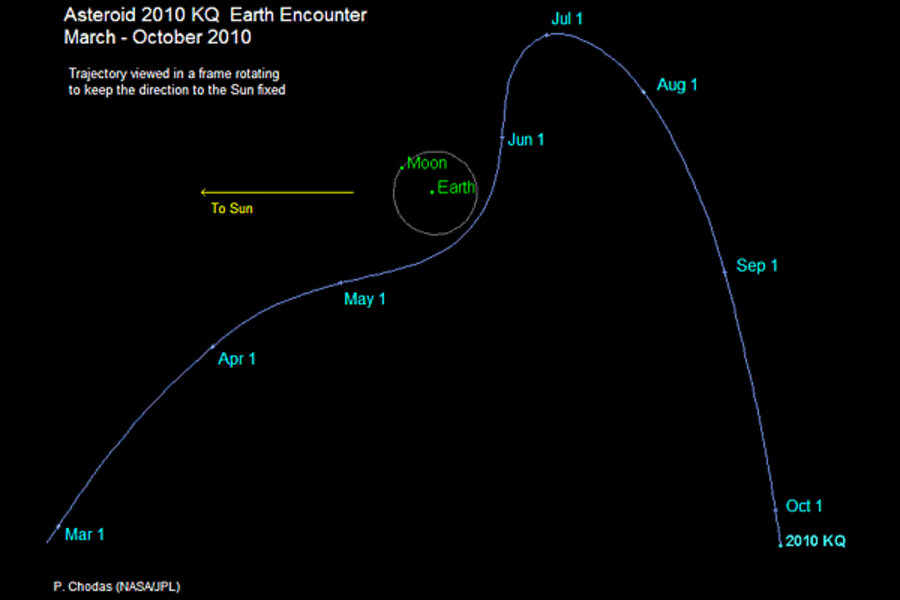NASA: Object that hurtled past Earth was space junk, not asteroid
Loading...
A small object that zipped by Earth this month is most likely just a wayward piece of space junk left over from an interplanetary mission that launched in times past, NASA officials said Thursday.
The unidentified object, known only as 2010 KQ, flew past Earth on May 21 at a distance just beyond the orbit of the moon, which is about 238,900 miles (384,402 km) from our planet. It is now slowly moving away from Earth.
After a careful analysis of its trajectory through space, NASA scientists concluded that 2010 KQ is space junk from an upper-stage rocket that launched a spacecraft to another destination in our solar system. It is likely just a few meters in size, they found.
IN PICTURES: NASA's journey into the universe
Like Earth, the object orbits the sun, scientists were able to calculate.
"The orbit of this object is very similar to that of the Earth, and one would not expect an object to remain in this type of orbit for very long," said Paul Chodas, a scientist at NASA's Near-Earth Object Program Office at the Jet Propulsion Laboratory in Pasadena, Calif., in a statement.
Chodas did not speculate on exactly what mission the rocket remnant may be left over from.
Mystery object 2010 KQ
2010 KQ was discovered on May 16 by astronomer Richard Kowalski from an observatory in the mountains north of Tucson, Ariz., as he participated in the Catalina Sky Survey, a NASA-sponsored effort to monitor the cosmos. NASA tracked the object for five days until it made its closest approach.
Follow up observations by astronomer S. J. Bus at the Infrared Telescope Facility atop Mauna Kea in Hawaii took a look at the object's spectral characteristics, which did not match any known asteroid categories – hinting that it is of human manufacture.
The small size estimate for 2010 KQ is based on its relative dimness in observations. The object has an absolute magnitude (a measure of brightness) of 28.9. For comparison, a magnitude 1 object shines about 100 brighter than a magnitude 5 one.
And this is not the last Earth has seen of 2010 KQ. The rocket remnant will return in 2036, but poses little risk of hitting the Earth and no chance of surviving the fiery inferno of atmospheric entry, Chodas said.
"At present, there is a 6 percent probability that 2010 KQ will enter our atmosphere over a 30-year period starting in 2036," Chodas said. "More than likely, additional observations of the object will refine its orbit and impact possibilities. Even in the unlikely event that this object is headed for impact with Earth, whether it is an asteroid or rocket body, it is so small that it would disintegrate in the atmosphere and not cause harm on the ground."
2036: Year of space junk and asteroids
The year 2036 has special resonance among space rock watchers. That's the year that another object, the huge asteroid Apophis, is also expected to fly relatively close by Earth.
Apophis gained fame as a potentially dangerous asteroid because of early predictions that gave it a slight chance of hitting Earth. In reality, it will miss the Earth on April 13, 2036 by about 18,300 miles (29,450 km).
There is only a 1-in-250,000 chance of Apophis striking the Earth, odds that NASA considers to be low.
Like 2010 KQ, Apophis will also be back. It will make a second pass by Earth in 2068, with the risk of an Earth-endangering impact also set at a low 1-in-333,000 chance.
Chodas and other scientists with NASA's Near-Earth Object Program regularly keep vigilant watch on asteroids and space debris to determine the risk to our planet, as well as among the satellites and spacecraft in orbit today. They use a network of telescopes on the ground and in space to perform the survey.
NASA also works with the U.S. military's Space Surveillance Network to track potentially dangerous space debris flying in low-Earth orbit. So far, there are more than 19,000 pieces of space junk in Earth orbit today, a count which may not include interplanetary bits of junk like 2010 KQ that zip by every now and then.





